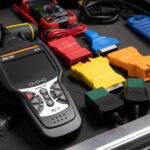It’s a common experience for car owners: the dreaded visit to the dealership for a diagnostic check. Often accompanied by a hefty bill, this process can feel opaque and leave you wondering if there was a more affordable, transparent way. Enter the OBD2 scanner, a tool that empowers drivers to understand their vehicle’s health themselves. For a small investment in an OBD2 device and a compatible app, like spending just $10 for a month’s access, you can perform tasks that once required a dealer visit, such as silencing that persistent seatbelt chime or customizing vehicle settings. This convenience and cost-effectiveness naturally bring up the question: why do dealers seem to dislike OBD2 scanners?
The core of the issue lies in the traditional dealership service model. Dealerships generate significant revenue from diagnostic services and repairs. OBD2 scanners, especially when paired with user-friendly apps, offer an alternative path for car owners. Instead of scheduling an appointment and paying dealership labor rates for a simple diagnostic check, drivers can use an OBD2 scanner to read trouble codes themselves, potentially identifying minor issues or confirming the need for professional repair before even setting foot in a service center. Furthermore, more advanced OBD2 tools and apps allow for vehicle customization and feature adjustments that dealerships might typically charge for, or even discourage.
Consider the example of wanting to make personalized changes to your car’s settings. As one user found, tools like Carista offer a straightforward way to adjust vehicle behavior. While Carista is user-friendly and works well for supported vehicles, it might be limited in scope. For users with multiple vehicles or specific needs, like diagnosing a BMW motorcycle with Motoscan, a more versatile OBD2 adapter like the OBDLink LX becomes invaluable. Although pricier upfront, the OBDLink LX works with a wider range of apps, providing broader diagnostic and customization capabilities across different vehicle brands.
It’s not just about reading error codes. Some apps linked to OBD2 scanners allow users to make permanent software changes, accessing functionalities previously exclusive to dealer technicians. While some apps might charge per vehicle model for these advanced features, the overall cost can still be significantly less than repeated dealership visits. The availability of affordable and capable OBD2 tools challenges the dealership’s role as the sole gatekeeper of vehicle diagnostics and customization.
In conclusion, while dealerships offer comprehensive services and expertise, the rise of OBD2 scanners empowers car owners with greater control over their vehicles. The potential for DIY diagnostics and customization, coupled with cost savings, understandably creates a tension. It’s not necessarily that dealers “hate” OBD2, but rather that these tools represent a shift in the automotive service landscape, potentially impacting traditional revenue streams and requiring dealerships to adapt to a more informed and empowered customer base.
